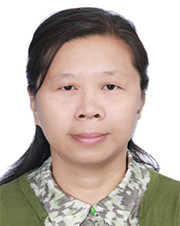
GAO Ge
GAO Ge(高歌) Professor-Level Senior Engineer
Tel: 0086-13621195723
2012 First Prize of DAYU Water Science and Technology Progress Award
2019 Second Prize of Geographic Information Science and Technology Progress Award
2005-2010 Ph.D. in Climate Impact on Water Resources, Earth Sciences Centre, Göteborg University, Sweden. Thesis Topic/Research Focus: Changes of evapotranspiration and water cycle in China over the past decades.
1994-1997 M.S. in Climatology, Department of Applied Meteorology, Nanjing Institute of Meteorology, China. Thesis Topic/Research Focus: Study of Tibetan Plateau solar radiation climate assessment.
1990-1994 B.S. in Climatology, Department of Applied Meteorology, Nanjing Institute of Meteorology, China
1997- Present National Climate Center, CMA
Engaged in climate disaster monitoring, disaster assessment, pre-assessment and risk regionalization over China, with particular regard to methods and index research;
Supplying monitoring and assessment information of extreme climate events and suggestions for disaster mitigation to various users.
Meteorological disaster risk assessment; climate application.
1. “Change Mechanism and Trend Prediction of Runoffs and Sediments in the Yellow River Basin”, a Jul. 2016-Jun. 2020 project supported by National Basic Research and Development Program of China.
2. “Research on Risk Assessment Methods for Regional Extreme Weather and Climate Events and Meteorological Disasters”, a Jan. 2017-Dec. 2017 project supported by the CMA Climate Change Special Fund.
3. “Meteorological Support for Mountain Torrent-Related Geological Disaster Prevention and Control at the National Climate Center”, a 2012-2016 project supported by CMA.
4. “Using Critical Rainfall Determination Technology to Alleviate River Network Waterlogging in Urban and Plain Areas”, a Jan. 2014-Dec. 2015 project supported by the CMA Key Technology Integration and Application Program.
5. “Zoning Meteorological Disaster Risks in China against the Background of Global Change”, a Nov. 2009-Dec. 2011 project supported by CMA Special Fund for Meteorological Research in the Public Interest.
6. The 2008 CMA-supported project of Climate Change Impact on Hydraulic Engineering Construction in China.
7. “A Study of Key Technologies for the Monitoring, Detection and Prediction of Extreme Climate Events and Serious Meteorological Disasters in China”, a 2008-2011 project supported by the Ministry of Science and Technology of the People’s Republic of China.
8. “Principle of Water Cycle Evolution and High Efficiency Utilization of Water in the Hai River Basin”, a 2007-2011project supported by the Ministry of Science and Technology of the People’s Republic of China.
9. The 2007 CMA-supported project of “Heat-Wave Monitoring, Assessment and Prediction Operational System”.
10. The 2006 CMA-supported project of “Climate Change Impact on Water Resources in the Yellow River Basin”.
1. G. Gao and C.Y. Huang (2001). “Climate change and its impact on water resources in North China.” Advances in Atmospheric Sciences, 18, 718-732.
2. D. L. Chen, G. Gao, C. Y. Xu, J. Gao, and G. Ren (2005). “Comparison of Thornthwaite method and Pan data with the standard Penman-Monteith estimates of potential evapotranspiration for China.” Climate Research, 28, 123-132.
3. G. Gao, D. L. Chen, G. Y. Ren, Y. Chen, and Y.M. Liao (2016). “Spatial and temporal variations and controlling factors of potential evapotranspiration in China:1956-2000.” Journal of Geographical Sciences, 16(1), 3-12.
4. G. Gao, D. L. Chen, C. Y. Xu, and E. Simelton (2007). “Trend of estimated actual evapotranspiration over China during 1960-2002.” Journal of Geophysical Research, 112, D11120; DOI:10.1029/2006JD008010.
5. G. Gao, D. L. Chen, and Y. Xu (2008). “Impact of climate change on runoff in the Huaihe River Basins.” Journal of Applied Meteorological Science, 19(6), 741-748.
6. G. Gao (2008). “The Climatic characteristics and change of haze days over China during 1961-2005.” Acta Geographica Sinica, l63(7), 761-768.
7. H.Y. Zhao, G. Gao, X. D. Yan, Q. Zhang, M. T. Hou, Y. Y. Zhu, and Z. Tian (2011). “Risk assessment of agricultural drought using the CERES-Wheat model: a case study of Henan Plain, China.” Climate Research, 50(2-3); DOI:10.3354/cr01060.
8. G. Gao, C. Y. Xu, D. L. Chen, et al. (2012). “Spatial and temporal characteristics of actual evapotranspiration over Haihe River basin in China.” Stochastic Environmental Research and Risk Assessment, 26, 655-669.
9. H.Y. Zhao, G. Gao, et al. (2015). “Timescale differences between SC-PDSI and SPEI for drought monitoring in China.” Physics & Chemistry of the Earth, Parts A/B/C, 102, 48-58.
10. X. H. Wu, L. Zhou, G. Gao, J. Guo, Z. H. Ji (2016). “Urban flood depth-economic loss curves and their amendment based on resilience: evidence from Lizhong Town by Lixia River and Houbai Town by Jurong River of China.” Natural Hazards, 82, 1981-2000.
11. R. Y. Zhang, G. Gao, J. F. Xiao, X. Wu, F. Xue, and R. J. Bao (2018). “Analysis on the Cause of Mayang Stream’s Mountain Torrent Disaster of the Typhoon Meranti (201614).” Journal of Geoscience and Environment Protection, 6(8), 87-104; DOI: 10.4236/gep.2018.68008.
12. D. P. Huang, L. Zhang, G. Gao, et al. (2018). “Projected changes in population exposure to extreme heat in China under a RCP8.5 scenario.” Journal of Geographical Sciences, 28(10), 1371-1384.
Friendly link
Links to GPC websites
Links to NMHSs in RA II
Copyright:© 2005 ~ 2023 Beijing Climate Centre. All rights reserved. Technical support: zhongyan
address:46 South Street, Zhongguancun, Haidian District, Beijing Zip code:100081
Today:20077/Total:34662432